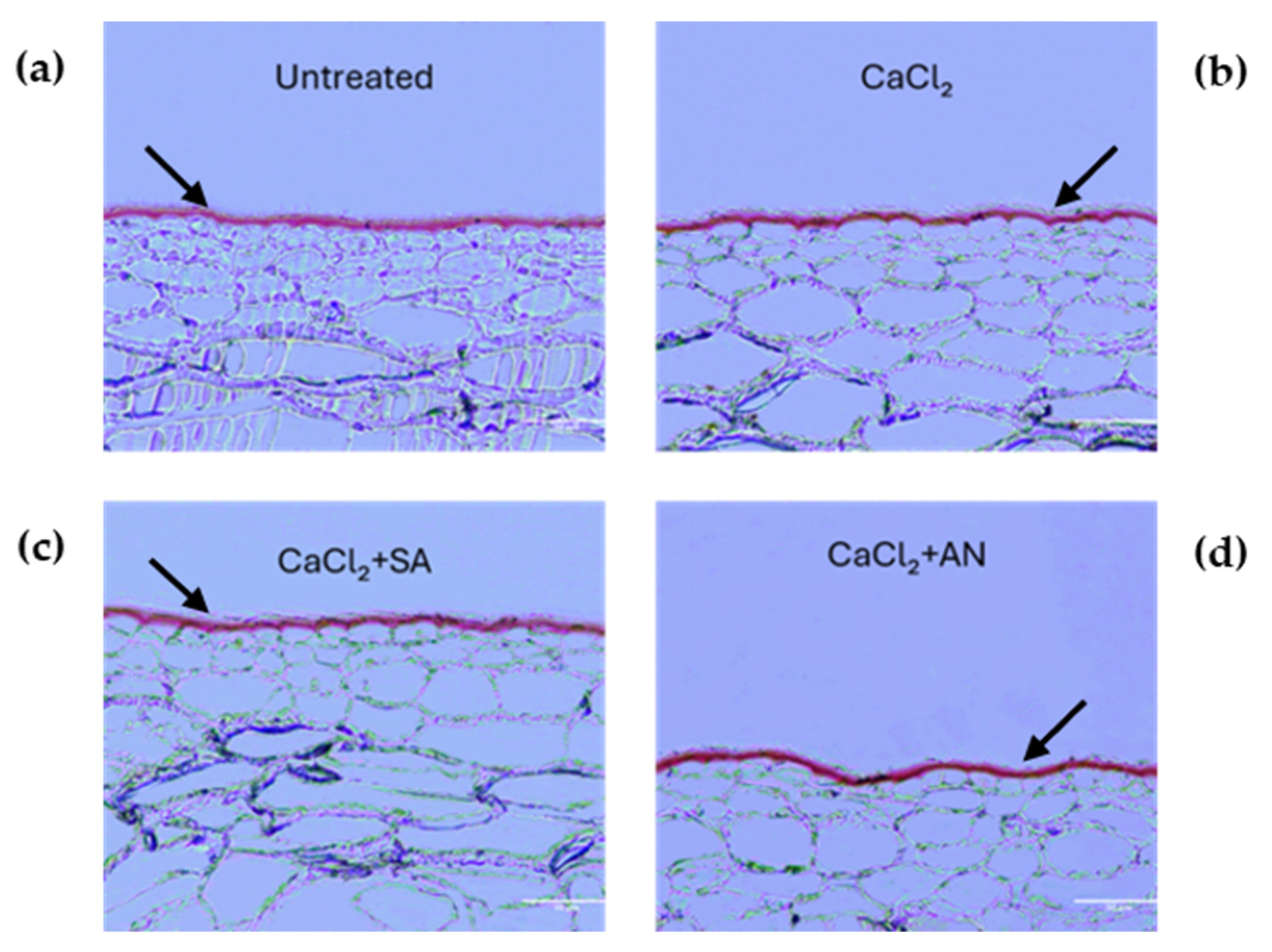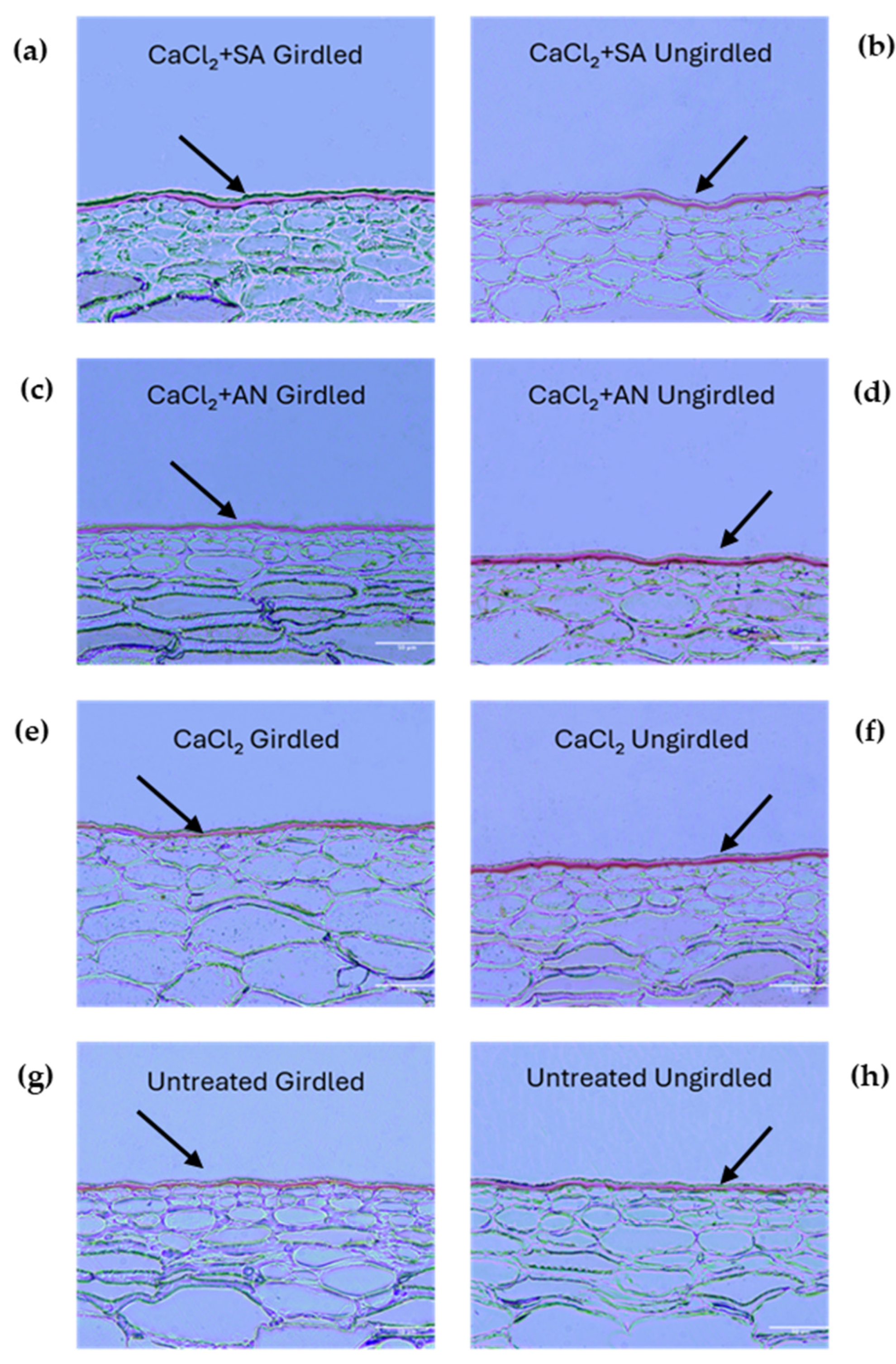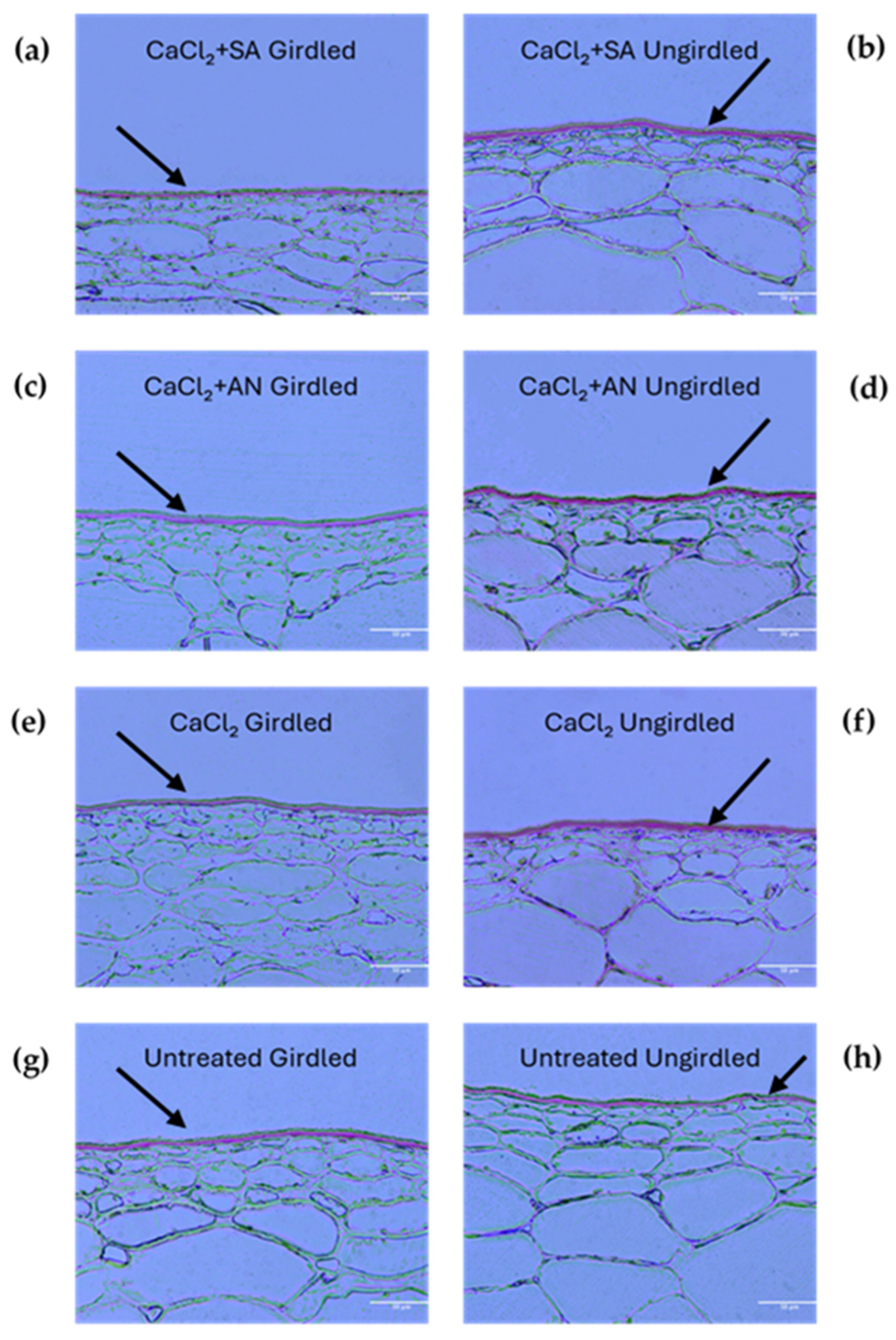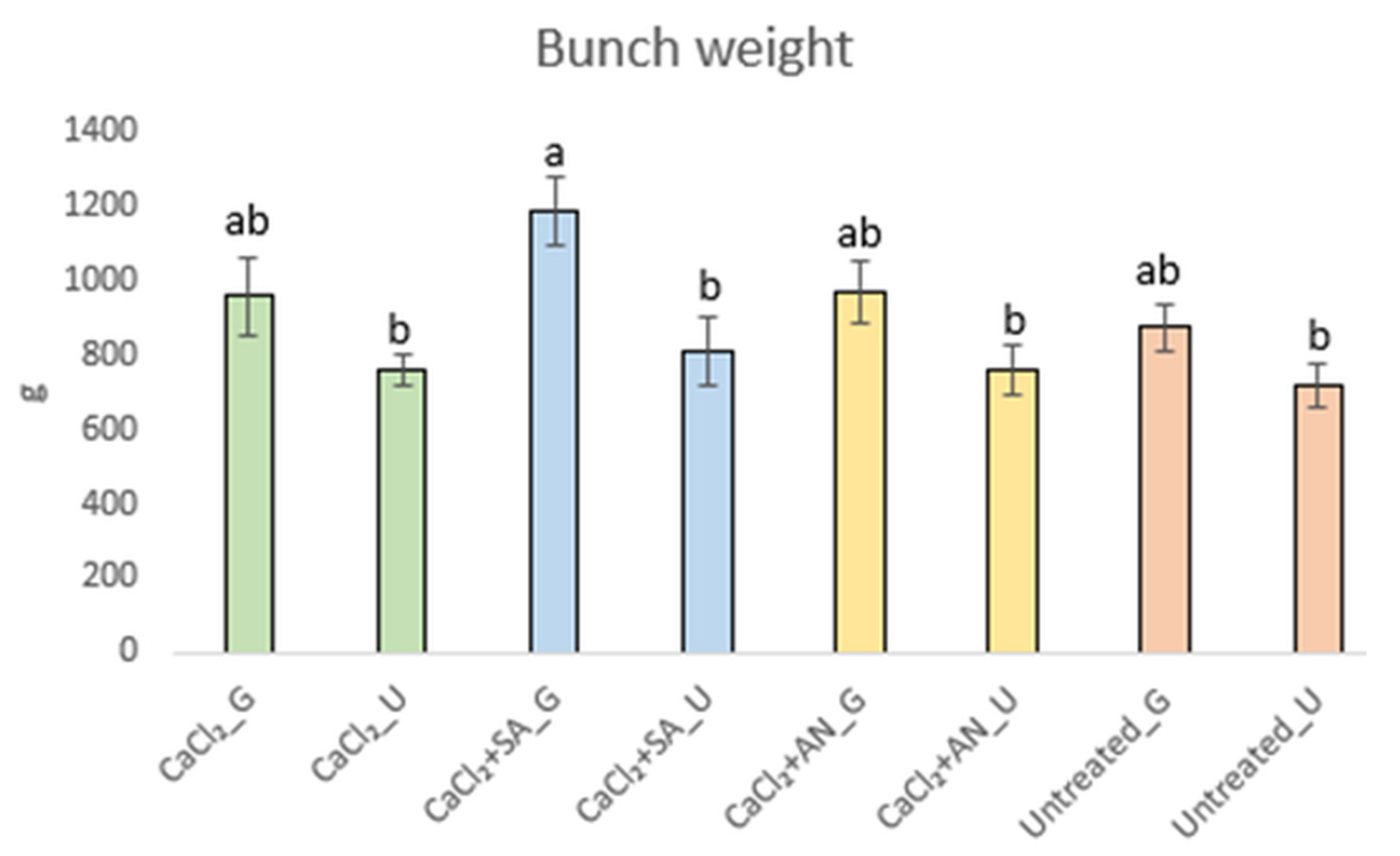Improving Cuticle Thickness and Quality Traits in Table Grape cv. ‘Italia’ Using Pre-Harvest Treatments
Abstract
:1. Introduction
2. Results and Discussion
2.1. Histological Results
2.2. Fruit Quality Assays
3. Materials and Methods
3.1. Sampling
3.2. Chemical Compounds
3.3. Fruit Quality Analyses
3.4. Texture and TPA Analyses
3.5. Embedding Protocol
3.6. Brightfield Microscopy and Image Analyses
3.7. Statistical Analysis
4. Conclusions
Supplementary Materials
Author Contributions
Funding
Data Availability Statement
Acknowledgments
Conflicts of Interest
References
- Torres-Palazzolo, C.; Ferreyra, S.; Hugalde, I.P.; Kuhn, Y.; Combina, M.; Ponsone, M.L. Recent advances in biocontrol and other alternative strategies for the management of postharvest decay in table grapes. Int. J. Food Microbiol. 2024, 420, 110766. [Google Scholar] [CrossRef] [PubMed]
- International Organisation of Vine and Wine. Annual Assessment of the World Vine and Wine Sector in 2022. 2022. Available online: https://www.oiv.int/sites/default/files/documents/OIV_Annual_Assessment-2023.pdf (accessed on 27 June 2024).
- Shi, H.; Zhou, X.; Qin, M.; Wang, W.; He, X.; Zhou, W. Effect of cacl2 sprays in different fruit development stages on grape berry cracking. Front. Plant Sci. 2022, 13, 870959. [Google Scholar] [CrossRef] [PubMed]
- Simon, G. Review on rain induced fruit cracking of sweet cherries (Prunus avium L.), its causes and the possibilities of prevention. Int. J. Hortic. Sci. 2006, 12, 27–35. [Google Scholar] [CrossRef]
- Khadivi-Khub, A. Physiological and genetic factors influencing fruit cracking. Acta Physiol. Plant 2015, 37, 1718. [Google Scholar] [CrossRef]
- Karantzi, A.D.; Kafkaletou, M.; Tsaniklidis, G.; Bai, J.; Christopoulos, M.V.; Fanourakis, D.; Tsantili, E. Preharvest foliar salicylic acid sprays reduce cracking of fig fruit at harvest. Appl. Sci. 2021, 11, 11374. [Google Scholar] [CrossRef]
- Correia, S.; Schouten, R.; Silva, A.P.; Gonçalves, B. Sweet cherry fruit cracking mechanisms and prevention strategies: A review. Sci. Hortic. 2018, 240, 369–377. [Google Scholar] [CrossRef]
- Peet, M.M. Fruit cracking in tomato. Horttechnology 1992, 2, 216–223. [Google Scholar] [CrossRef]
- Intergovernmental Panel on Climate Change. Weather and climate. In Climate Change 2021—The Physical Science Basis; Cambridge University Press: Cambridge, UK, 2023; pp. 1513–1766. [Google Scholar]
- La Spada, P.; Dominguez, E.; Continella, A.; Heredia, A.; Gentile, A. Factors influencing fruit cracking: An environmental and agronomic perspective. Front. Plant Sci. 2024, 15, 1343452. [Google Scholar] [CrossRef]
- Brüggenwirth, M.; Knoche, M. Factors affecting mechanical properties of the skin of sweet cherry fruit. J. Am. Soc. Hort. Sci. 2016, 141, 45–53. [Google Scholar] [CrossRef]
- Brüggenwirth, M.; Knoche, M. Mechanical properties of skins of sweet cherry fruit of differing susceptibilities to cracking. J. Am. Soc. Hort. Sci. 2016, 141, 162–168. [Google Scholar] [CrossRef]
- Brüggenwirth, M.; Fricke, H.; Knoche, M. Biaxial tensile tests identify epidermis and hypodermis as the main structural elements of sweet cherry skin. AoB Plants 2014, 6, plu019. [Google Scholar] [CrossRef] [PubMed]
- Matas, A.J.; López-Casado, G.; Cuartero, J.; Heredia, A. Relative humidity and temperature modify the mechanical properties of isolated tomato fruit cuticles. Am. J. Bot. 2005, 92, 462–468. [Google Scholar] [CrossRef] [PubMed]
- Domínguez, E.; Cuartero, J.; Heredia, A. An overview on plant cuticle biomechanics. Plant Sci. 2011, 181, 77–84. [Google Scholar] [CrossRef] [PubMed]
- Khanal, B.P.; Knoche, M. Mechanical properties of cuticles and their primary determinants. J. Exp. Bot. 2017, 68, 5351–5367. [Google Scholar] [CrossRef] [PubMed]
- Fernández-Muñoz, R.; Heredia, A.; Domínguez, E. The role of cuticle in fruit shelf-life. Curr. Opin. Biotechnol. 2022, 78, 102802. [Google Scholar] [CrossRef]
- Curvers, K.; Seifi, H.; Mouille, G.; de Rycke, R.; Asselbergh, B.; Van Hecke, A.; Vanderschaeghe, D.; Höfte, H.; Callewaert, N.; Van Breusegem, F.; et al. Abscisic acid deficiency causes changes in cuticle permeability and pectin composition that influence tomato resistance to Botrytis cinerea. Plant Physiol. 2010, 154, 847–860. [Google Scholar] [CrossRef]
- Matushkina, N.; Gorb, S. Mechanical properties of the endophytic ovipositor in damselflies (Zygoptera, Odonata) and their oviposition substrates. Zoology 2007, 110, 167–175. [Google Scholar] [CrossRef]
- Hetzroni, A.; Vana, A.; Mizrach, A. Biomechanical characteristics of tomato fruit peels. Postharvest Biol. Technol. 2011, 59, 80–84. [Google Scholar] [CrossRef]
- Jiang, B.; Liu, R.; Fang, X.; Tong, C.; Chen, H.; Gao, H. Effects of salicylic acid treatment on fruit quality and wax composition of blueberry (Vaccinium virgatum Ait). Food Chem. 2022, 368, 130757. [Google Scholar] [CrossRef]
- Vangdal, E.; Hovland, K.L.; Børve, J.; Sekse, L.; Slimestad, R. Foliar application of calcium reduces postharvest decay in sweet cherry fruit by various mechanisms. Acta Hortic. 2008, 768, 143–148. [Google Scholar] [CrossRef]
- Erogul, D. Effect of preharvest calcium treatments on sweet cherry fruit quality. Not. Bot. Horti Agrobot. Cluj-Napoca 2014, 42, 150–153. [Google Scholar] [CrossRef]
- Demirsoy, L.K.; Bilgener, S. The effects of preharvest calcium hydroxide applications on cracking in 0900 ‘Zirat’, ‘Lamberbert’ and ‘Van’ Sweet cherries. Acta Hortic. 1998, 657–662. [Google Scholar] [CrossRef]
- Lang, G.; Guimond, C.; Southwick, S.; Kappel, F.; Flore, J.A.; Facteau, T.; Azarenko, A. Performance of calcium/sprinkler-based strategies to reduce sweet cherry rain-cracking. Acta Hortic. 1998, 649–656. [Google Scholar] [CrossRef]
- Wójcik, P.; Akgül, H.; Demirtaş, İ.; Sarısu, C.; Aksu, M.; Gubbuk, H. Effect of preharvest sprays of calcium chloride and sucrose on cracking and quality of ‘burlat’ sweet cherry fruit. J. Plant Nutr. 2013, 36, 1453–1465. [Google Scholar] [CrossRef]
- Winkler, A.; Knoche, M. Calcium and the physiology of sweet cherries: A review. Sci. Hortic. 2019, 245, 107–115. [Google Scholar] [CrossRef]
- Continella, A.; Ferlito, F.; Gentile, A.; La Malfa, S. Effect of plant growth regulators for enhancing fruit quality in Italian citrus industry. Acta Hortic. 2023, 139–146. [Google Scholar] [CrossRef]
- Davis, K.; Stover, E.; Wirth, F. Economics of fruit thinning: A review focusing on apple and citrus. Horttechnology 2004, 14, 282–289. [Google Scholar] [CrossRef]
- Ginzberg, I.; Stern, R.A. Strengthening fruit-skin resistance to growth strain by application of plant growth regulators. Sci. Hortic. 2016, 198, 150–153. [Google Scholar] [CrossRef]
- Stern, R.; Ben-Arie, R.; Ginzberg, I. Reducing the incidence of calyx cracking in ‘Pink Lady’ apple using a combination of cytokinin (6-benzyladenine) and gibberellins (GA4+7). J. Hortic. Sci. Biotechnol. 2013, 88, 147–153. [Google Scholar] [CrossRef]
- Ginzberg, I.; Fogelman, E.; Rosenthal, L.; Stern, R.A. Maintenance of high epidermal cell density and reduced calyx-end cracking in developing ‘Pink Lady’ apples treated with a combination of cytokinin 6-benzyladenine and gibberellins A4+A7. Sci. Hortic. 2014, 165, 324–330. [Google Scholar] [CrossRef]
- Usenik, V. Physicochemical changes of sweet cherry fruits related to application of gibberellic acid. Food Chem. 2005, 90, 663–671. [Google Scholar] [CrossRef]
- Yılmaz, C.; Özgüven, A.I. The effects of some plant nutrients, gibberellic acid and pinolene treatments on the yield, fruit quality and cracking in pomegranate. Acta Hortic. 2009, 205–212. [Google Scholar] [CrossRef]
- Suran, P.; Vávra, R.; Zelený, L. Effectiveness of potential products to reduce rain cracking of cherry fruit. Acta Hortic. 2016, 183–186. [Google Scholar] [CrossRef]
- Zhang, M.; Liu, Y.; Chen, Z.; Zhi, Z.; Wang, A.; Yue, H.; Li, F.; Zhang, S.; Zhu, G. Progress in fruit cracking control of gibberellic acid and abscisic acid. Forests 2024, 15, 547. [Google Scholar] [CrossRef]
- Correia, S.; Oliveira, I.; Queirós, F.; Ribeiro, C.; Ferreira, L.; Luzio, A.; Silva, A.P.; Gonçalves, B. Preharvest application of seaweed based biostimulant reduced cherry (Prunus avium L.) cracking. Procedia Environ. Sci. 2015, 29, 251–252. [Google Scholar] [CrossRef]
- Rouphael, Y.; Colla, G. Editorial: Biostimulants in agriculture. Front. Plant Sci. 2020, 11, 40. [Google Scholar] [CrossRef]
- Gonçalves, B.; Morais, M.C.; Sequeira, A.; Ribeiro, C.; Guedes, F.; Silva, A.P.; Aires, A. Quality preservation of sweet cherry cv. ‘staccato’ by using glycine-betaine or Ascophyllum nodosum. Food Chem. 2020, 322, 126713. [Google Scholar] [CrossRef]
- Kazan, K.; Lyons, R. Intervention of phytohormone pathways by pathogen effectors. Plant Cell 2014, 26, 2285–2309. [Google Scholar] [CrossRef]
- Correia, S.; Schouten, R.; Silva, A.P.; Gonçalves, B. Factors Affecting Quality and Health Promoting Compounds during Growth and Postharvest Life of Sweet Cherry (Prunus avium L.). Front. Plant Sci. 2017, 8, 2166. [Google Scholar] [CrossRef]
- Afonso, S.; Oliveira, I.; Meyer, A.S.; Gonçalves, B. Biostimulants to Improved Tree Physiology and Fruit Quality: A Review with Special Focus on Sweet Cherry. Agronomy 2022, 12, 659. [Google Scholar] [CrossRef]
- Battacharyya, D.; Babgohari, M.Z.; Rathor, P.; Prithiviraj, B. Seaweed extracts as biostimulants in horticulture. Sci. Hortic. 2015, 196, 39–48. [Google Scholar] [CrossRef]
- Commenil, P.; Brunet, L.; Audran, J.-C. The development of the grape berry cuticle in relation to susceptibility to bunch rot disease. J. Exp. Bot. 1997, 48, 1599–1607. [Google Scholar] [CrossRef]
- Christensen, J.V. Cracking in Cherries. Acta Agric. Scand. 1973, 23, 52–54. [Google Scholar] [CrossRef]
- Knoche, M.; Lang, A. Ongoing growth challenges fruit skin integrity. CRC Crit. Rev. Plant Sci. 2017, 36, 190–215. [Google Scholar] [CrossRef]
- Chang, B.-M.; Keller, M. Cuticle and skin cell walls have common and unique roles in grape berry splitting. Hortic. Res. 2021, 8, 168. [Google Scholar] [CrossRef] [PubMed]
- Trentham, W.R.; Sams, C.E.; Conway, W.S. Histological effects of calcium chloride in stored apples. J. Am. Soc. Hort. Sci. 2008, 133, 487–491. [Google Scholar] [CrossRef]
- Indarwati, L.D.; Sulistyaningsih, E.; Kurniasih, B. Impact of salicylic acid and biosilica application on plant growth of shallot under water deficit. IOP Conf. Ser. Earth Environ. Sci. 2021, 883, 012049. [Google Scholar] [CrossRef]
- Schlegel, T.K.; Schönherr, J. Selective permeability of cuticles over stomata and trichomes to calcium chloride. Acta Hortic. 2002, 91–96. [Google Scholar] [CrossRef]
- Timpanaro, N.; Ferlito, F.; Amenta, M.; Torrisi, B.; Allegra, M.; Rapisarda, P.; Romeo, F.V. Effect of branch girdling on berry traits, chemical and sensory characteristics of ‘Italia’ and ‘Victoria’ table grapes. N. Z. J. Crop Hortic. Sci. 2023, 51, 52–68. [Google Scholar] [CrossRef]
- Goren, R.; Huberman, M.; Goldschmidt, E.E. Girdling: Physiological and horticultural aspects. In Horticultural Reviews; Janick, J., Ed.; Wiley: Hoboken, NJ, USA, 2003; pp. 1–36. [Google Scholar]
- Krajewski, A.; Ebert, T.; Schumann, A.; Waldo, L. Pre-Harvest Fruit Splitting of Citrus. Agronomy 2022, 12, 1505. [Google Scholar] [CrossRef]
- Rabe, E.; van Rensburg, P.; van der Walt, H.; Bower, J. Factors influencing preharverst fruit splitting in Ellendale (C. reticulata). Horts 1990, 25, 1135f–1135. [Google Scholar] [CrossRef]
- Soltekin, O.; Candemir, A.; Altindisli, A. Effects of cane girdling on yield, fruit quality and maturation of (Vitis vinifera L.) cv. Flame Seedless. BIO Web Conf. 2016, 7, 01032. [Google Scholar] [CrossRef]
- Peng, Y.; Gu, X.; Zhou, Q.; Huang, J.; Liu, Z.; Zhou, Y.; Zheng, Y. Molecular and physiologic mechanisms of advanced ripening by trunk girdling at early veraison of ‘Summer Black’ grape. Front. Plant Sci. 2022, 13, 1012741. [Google Scholar] [CrossRef]
- Tóth, A.M.; Zsófi, Z.; Veres, S. Cane girdling influence on the berry texture properties of three table grape varieties. Horticulturae 2022, 8, 1101. [Google Scholar] [CrossRef]
- Yahuaca, J.B.; Martínez-Peniche, R.; Madero, E.; Reyes, J.L. Effects of ethephon and girdling on firmness of “red malaga” table grape. Acta Hortic. 2001, 121–124. [Google Scholar] [CrossRef]
- Giménez, M.J.; Valverde, J.M.; Valero, D.; Guillén, F.; Martínez-Romero, D.; Serrano, M.; Castillo, S. Quality and antioxidant properties on sweet cherries as affected by preharvest salicylic and acetylsalicylic acids treatments. Food Chem. 2014, 160, 226–232. [Google Scholar] [CrossRef]
- Ali, S.; Masud, T.; Abbasi, K.S.; Mahmood, T.; Ali, A. Effect of Different Concentrations of Salicylic Acid on Keeping Quality of Apricot cv. Habi at Ambient Storage. Food Chem. Toxicol. 2013, 2, 69–78. [Google Scholar]
- Sirijariyawat, A.; Charoenrein, S. Texture and Pectin Content of Four Frozen Fruits Treated with Calcium. J. Food Process. Preserv. 2014, 38, 1346–1355. [Google Scholar] [CrossRef]
- Salvi, L.; Brunetti, C.; Cataldo, E.; Niccolai, A.; Centritto, M.; Ferrini, F.; Mattii, G.B. Effects of Ascophyllum nodosum extract on Vitis vinifera: Consequences on plant physiology, grape quality and secondary metabolism. Plant Physiol. Biochem. 2019, 139, 21–32. [Google Scholar] [CrossRef]
- Babalar, M.; Asghari, M.; Talaei, A.; Khosroshahi, A. Effect of pre- and postharvest salicylic acid treatment on ethylene production, fungal decay and overall quality of Selva strawberry fruit. Food Chem. 2007, 105, 449–453. [Google Scholar] [CrossRef]
- Shafiee, M.; Taghavi, T.S.; Babalar, M. Addition of salicylic acid to nutrient solution combined with postharvest treatments (hot water, salicylic acid, and calcium dipping) improved postharvest fruit quality of strawberry. Sci. Hortic. 2010, 124, 40–45. [Google Scholar] [CrossRef]
- Lo’ay, A.A.; El-Boray, M.S. Improving fruit cluster quality attributes of ‘Flame Seedless’ grapes using preharvest application of ascorbic and salicylic acid. Sci. Hortic. 2018, 233, 339–348. [Google Scholar] [CrossRef]
- Champa, W.A.H.; Gill, M.I.S.; Mahajan, B.V.C.; Arora, N.K. Preharvest salicylic acid treatments to improve quality and postharvest life of table grapes (Vitis vinifera L.) cv. Flame Seedless. J. Food Sci. Technol. 2015, 52, 3607–3616. [Google Scholar] [CrossRef] [PubMed]
- McLeod, T. Viticultural opportunities in Argentina. In Wines and Vines; Hiaring Company: Delhi, India, 1998; Volume 8. [Google Scholar]
- Mencarelli, F.; Bellincontro, A.; DiRenzo, G. Post-Harvest Technologies|Inpho|Food and Agriculture Organization of the United Nations. Grape: Post-harvest Operations. 2005. Available online: https://www.fao.org/fileadmin/user_upload/inpho/docs/Post_Harvest_Compendium_-_Grape.pdf (accessed on 17 August 2024).
- Correia, S.; Santos, M.; Glińska, S.; Gapińska, M.; Matos, M.; Carnide, V.; Schouten, R.; Silva, A.P.; Gonçalves, B. Effects of exogenous compound sprays on cherry cracking: Skin properties and gene expression. J. Sci. Food Agric. 2020, 100, 2911–2921. [Google Scholar] [CrossRef] [PubMed]
- Meier, U. BBCH-Monograph: Growth Stages of Mono- and Dicotyledonous Plants, 2nd ed.; Technical Report; Julius Kühn-Institut (JKI), Bundesforschungsinstitut für Kulturpflanzen: Quedlinburg, Germany, 2001; p. 158. [Google Scholar]
- McLaren, K. Food colorimetry. In Developments in Food Colours; Jack K. Burgess: Clayton, NC, USA, 1980. [Google Scholar]
- Silva, V.; Pereira, S.; Vilela, A.; Bacelar, E.; Guedes, F.; Ribeiro, C.; Silva, A.P.; Gonçalves, B. Preliminary insights in sensory profile of sweet cherries. Foods 2021, 10, 612. [Google Scholar] [CrossRef]
- Schindelin, J.; Arganda-Carreras, I.; Frise, E.; Kaynig, V.; Longair, M.; Pietzsch, T.; Preibisch, S.; Rueden, C.; Saalfeld, S.; Schmid, B.; et al. Fiji: An open-source platform for biological-image analysis. Nat. Methods 2012, 9, 676–682. [Google Scholar] [CrossRef]







| Treatment | Cuticle Thickness (µm) BBCH73 |
|---|---|
| CaCl2 | 4.89 ± (0.22) ab |
| CaCl2 + SA | 4.32 ± (0.11) b |
| CaCl2 + AN | 5.12 ± (0.24) a |
| Untreated | 4.82 ± (0.17) ab |
| Treatment | Cuticle Thickness (µm) BBCH75 | Cuticle Thickness (µm) BBCH81 | Cuticle Thickness (µm) BBCH89 |
|---|---|---|---|
| CaCl2_G | 3.31 ± (0.03) a | 2.03 ± (0.05) e | 1.71 ± (0.04) c |
| CaCl2_U | 3.32 ± (0.07) a | 3.41 ± (0.08) a | 1.93 ± (0.07) abc |
| CaCl2 + SA_G | 2.81 ± (0.06) bc | 2.53 ± (0.09) cd | 2.05 ± (0.09) ab |
| CaCl2 + SA_U | 3.40 ± (0.12) a | 2.60 ± (0.04) cd | 1.91 ± (0.06) abc |
| CaCl2 + AN_G | 2.56 ± (0.06) bc | 2.76 ± (0.08) bc | 2.06 ± (0.07) ab |
| CaCl2 + AN_U | 3.43 ± (0.10) a | 2.93 ± (0.10) b | 1.83 ± (0.042) bc |
| Untreated_G | 2.49 ± (0.06) c | 2.36 ± (0.06) de | 1.76 ± (0.07) bc |
| Untreated_U | 2.97 ± (0.09) ab | 2.68 ± (0.07) bcd | 2.19 ± (0.10) a |
| Treatment | Penetration Force (N) |
|---|---|
| CaCl2_G | 4.63 ± (0.15) ab |
| CaCl2_U | 3.61 ± (0.12) d |
| CaCl2 + SA_G | 4.66 ± (0.13) ab |
| CaCl2 + SA_U | 5.01 ± (0.12) a |
| CaCl2 + AN_G | 4.21 ± (0.15) bc |
| CaCl2 + AN_U | 4.73 ± (0.16) ab |
| Untreated_G | 3.99 ± (0.12) cd |
| Untreated_U | 4.54 ± (0.16) abc |
| Treatment | L | a | b | Chroma | Hue° |
|---|---|---|---|---|---|
| CaCl2_G | 40.40 ± (0.20) b | −4.21 ± (0.10) cd | 11.39 ± (0.13) ab | 12.20± (0.15) abc | 110.23 ± (0.38) a |
| CaCl2_U | 39.84 ± (0.24) b | −3.99 ± (0.10) abc | 10.63 ± (0.17) bc | 11.27± (0.20) cd | 108.30 ± (1.60) a |
| CaCl2 + SA_G | 39.69 ± (0.20) b | −4.54 ± (0.12) d | 11.33 ± (0.20) ab | 12.25± (0.21) ab | 110.51 ± (1.18) a |
| CaCl2 + SA_U | 40.56 ± (0.18) b | −3.86 ± (0.11) abc | 11.36 ± (0.23) ab | 12.02± (0.25) abcd | 108.86 ± (0.44) a |
| CaCl2 + AN_G | 39.72 ± (0.17) b | −3.51 ± (0.14) a | 10.43 ± (0.17) c | 11.07 ± (0.19) d | 108.89 ± (0.47) a |
| CaCl2 + AN_U | 40.28 ± (0.17) b | −4.34 ± (0.16) cd | 11.95 ± (0.22) a | 12.80 ± (0.25) a | 110.22 ± (0.36) a |
| Untreated_G | 40.20 ± (0.20) b | −3.65 ± (0.10) ab | 11.05 ± (0.21) bc | 11.68± (0.21) bcd | 108.58 ± (0.46) a |
| Untreated_U | 41.50 ± (0.23) a | −4.19± (0.12) bcd | 11.42 ± (0.22) ab | 12.19± (0.24) abc | 108.93 ± (1.16) a |
Disclaimer/Publisher’s Note: The statements, opinions and data contained in all publications are solely those of the individual author(s) and contributor(s) and not of MDPI and/or the editor(s). MDPI and/or the editor(s) disclaim responsibility for any injury to people or property resulting from any ideas, methods, instructions or products referred to in the content. |
© 2024 by the authors. Licensee MDPI, Basel, Switzerland. This article is an open access article distributed under the terms and conditions of the Creative Commons Attribution (CC BY) license (https://creativecommons.org/licenses/by/4.0/).
Share and Cite
La Spada, P.; Continella, A.; Dominguez, E.; Heredia, A.; Gentile, A. Improving Cuticle Thickness and Quality Traits in Table Grape cv. ‘Italia’ Using Pre-Harvest Treatments. Plants 2024, 13, 2400. https://doi.org/10.3390/plants13172400
La Spada P, Continella A, Dominguez E, Heredia A, Gentile A. Improving Cuticle Thickness and Quality Traits in Table Grape cv. ‘Italia’ Using Pre-Harvest Treatments. Plants. 2024; 13(17):2400. https://doi.org/10.3390/plants13172400
Chicago/Turabian StyleLa Spada, Paolo, Alberto Continella, Eva Dominguez, Antonio Heredia, and Alessandra Gentile. 2024. "Improving Cuticle Thickness and Quality Traits in Table Grape cv. ‘Italia’ Using Pre-Harvest Treatments" Plants 13, no. 17: 2400. https://doi.org/10.3390/plants13172400






